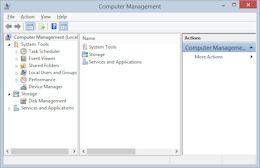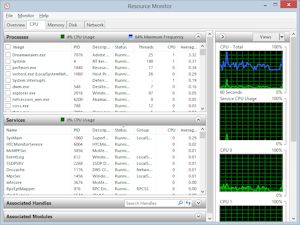
 |
Windows Guide |
The Windows operating systems comes with some advanced tools to manage your operating system. Some of these tools are loaded into a Microsoft Management Console (MMC) and are Management Snapins (MSC) as they can be 'snapped in' with other msc's in the same console.
See Accessories for other tools.
Component Services
This manages COM+ applications which are mainly used by developers and administrators. See the Help and Support documentation on this complex area.
Computer Management
This allows access to most tools to manage your computer including the Task Scheduler, Event Viewer, Shared folders, Local Users and Groups, Performance, Device Manager, Disk Management, and Services and so on from the same console. This tool can also be accessed by right clicking This PC icon and selecting Manage from the pop up menu.

Defragment and Optimise Drives
This tool allows you to analyze and defragment your files on your hard drive. Drives are optimised automatically for you to prevent severe fragmentation and slow disk access.
Disk Clean-up
This tool allows you to remove old temporary files, log files, dump files, downloaded files, error reports, thumbnails and empty your recycle bin to free up disk space.
Event Viewer
Everything that happens on a Windows can trigger an 'event' such as booting up, shutting down, hardware problems, application problems and security. These 'events' are logged in the background into four logs: Application, Security, Setupand System. Additional Microsoft specific logs afor things like Hardware, Internet Explorer, Office, SQL and Powershell events can be found in the Applications and Services Logs. You ccan now create your own custom logs to view specific events that you are interested in.

Errors marked with a Red Cross, a warning as a Yellow trianle and information as a Blue balloon. Errors should be dealt with. Doubling clicking an event will bring up more detail about it and show when it occured, the source, an Event ID and a Description. The Event ID is very useful because this can be used to look up problems on Microsoft's Knowledge Base database.
Internet Information Services (IIS) Manager
This allows you to manage and configure the Web Server in Windows.
iSCSI Initiator
This tool allows you to connect to SCSI drives over the network. See this step by step guide.
Local Security Policy
Set local settings for accounts, user rights, security options, firewall, network list manager, public key, software restrictions, application control, IP security and advanced audit policy.
ODBC Data Sources (32/64-bit)
This allows you to set up Open DataBase Connectivity sources to allow applications to access databases such as FoxBase, Access, Excel, Paradox, dBase and SQL databases by setting up Data Source Names to access them by name. See Help for more information.
Performance Monitor
This console allows you to monitor performance of your computer so you can see how much workload your computer is under and therefore see where potential problems can occur. Each part of the computer has a special Counter that can be monitored by adding it to a chart or a graph such as memory usage, disk read/writes, processor load and so on. These counters can be used to set alerts when counters reach a certain level and can also be logged to be viewed later.

Power Automate
Automate power management via prebuilt drag-and-drop actions or records your own flows.
Print Management
This tools allows you manage printers and print drivers and other printers on print servers.
Recovery Drive
Create a recovery drive to start your PC if Windows fails to boot. It backs up system files to the drive.
Registry Editor
Edit local computer and user settings for Windows and Applications.
Resource Monitor
This is an advanced monitoring tool that can ddisplay detailed perofrmance on the CPU, Memory, Disk and the Network to help you find out whether your system is slow, over worked or not performing properly in any way.

Services
When Windows loads up, some of the operating system's functions is to service special areas such as networking, printing, device control, security and applications. These are labelled as services and are started up when you boot up Windows. These can be controlled from the Services console.
Each service is shown with a name, description, status, startup type and Logon name. Start up types can be Disabled (do not run), Manual (may run but not immediately) and Automatic (always run). Those listed with status Running have been loaded and started up. A lot of these services are essential and if stopped or disabled can seriously affect your computer. Do not stop or disable services unless you are certain they are needed.
Right clicking a service lists a number of tasks such as Start, Stop, Restart and Properties. Clicking properties allow you to change the startup type, set a logon account (most use the Local System account) and stop and start a service.
System Configuration
This loads up the configuration window which allows you to specify the type of startup to use (Normal, diagnostic or selective), any special boot options (e.g. Safe mode), Services or programs to start, and access to additional system tools.
System Information
This load the System Information program which gives more details about Windows, the Hardware and the Software installed on the system. Hardware information includes conflicts, DMA, I/O, IRQs and memory usage. Components include disks, CD-ROM, sound, display, input, modem, network, printers and USB. Software infromation includes drivers, variables, network connections, running tasks, services, programs, start-up programs, OLE registration and windows error reporting.
Task Manager
View tasks, processes, performance, app history, startup, users and services.
Task Scheduler
This tool allows you to view, create and manage tasks that are run either at startup, run once or on a schedule. Task are split into various sub-groups in the Library for Microsoft, Games, Event Viewer and third party applications.
Windows Defender Firewall with Advanced Security
This tool gives more advanced options to configure the Windows Firewall for specific profiles (Domain, Private, Public), Outbound and inbound rules, connction security rules and so on. You can create your own rules for specialised software or for specific network protocols.
Windows Memory Diagostic
This tool allows you to check your systems memory for any problems which may cause your system to crash. It requires a reboot to start the tools in Advanced Options without Windows runnings.